This post may contain affiliate links. If you click and buy, we may earn a small commission at no extra cost to you. Learn more.
White kitchens are always in style. They add elegance to any home, big or small. Whether you’re updating or renovating, white kitchens fit any taste.
Find out how a white kitchen can change your home. This guide will show you design trends, material choices, and practical tips. You’ll learn about storage, lighting, and color accents that highlight white kitchen ideas. Ready to make your kitchen new? Let’s design it together.
Contents
- 1 The Timeless Appeal of White Kitchens
- 2 Key Design Elements for a White Kitchen
- 3 Lighting Solutions for Bright White Spaces
- 4 Incorporating Color Accents
- 5 Functional Layouts That Work
- 6 Budgeting for Your Dream White Kitchen
- 7 Sustainability in White Kitchen Design
- 8 Maintenance Tips for a White Kitchen
- 9 Inspiring White Kitchen Examples
The Timeless Appeal of White Kitchens
White kitchens are a top choice in American homes. They mix style and function beautifully. Their clean look makes any space feel welcoming and elegant. A white kitchen design lets you add your personal touch without cluttering the area.
Why Choose White?
Here’s why people and designers adore white kitchens:
- Light Maximization: White surfaces bounce light, making rooms look bigger and brighter.
- Timeless Versatility: A white kitchen stays on trend easily—just change the decor, not the paint.
- Hygiene and Cleanliness: White surfaces instantly make a space feel fresh and tidy.
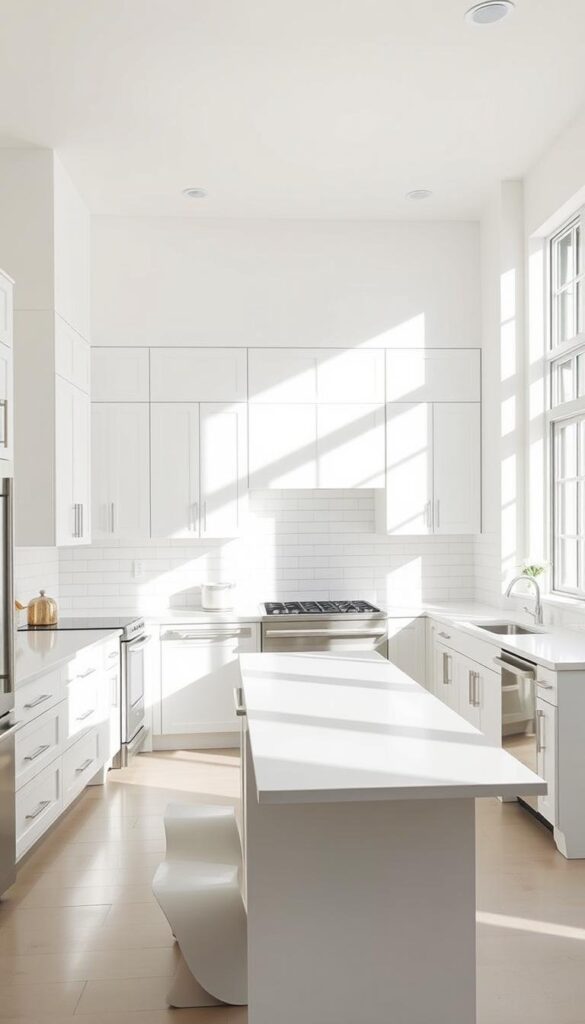
Popular Styles
White kitchens look great in many styles:
- Scandinavian: Mix white cabinets with wooden floors and greenery for a cozy Nordic feel.
- Traditional Farmhouse: Add whitewashed beams or floral touches to classic white cabinets.
- Modern Minimalist: Choose glossy white appliances and geometric tiles for a sharp look.
“A white kitchen isn’t just a color—it’s a foundation for creativity.”
White kitchens suit both elegance and simplicity. See how these styles can match your home’s character.
Key Design Elements for a White Kitchen
Creating a cohesive white kitchen starts with the right design elements. Cabinets, countertops, and backsplashes define style and function. Each choice balances looks with practicality, making the space beautiful and durable.
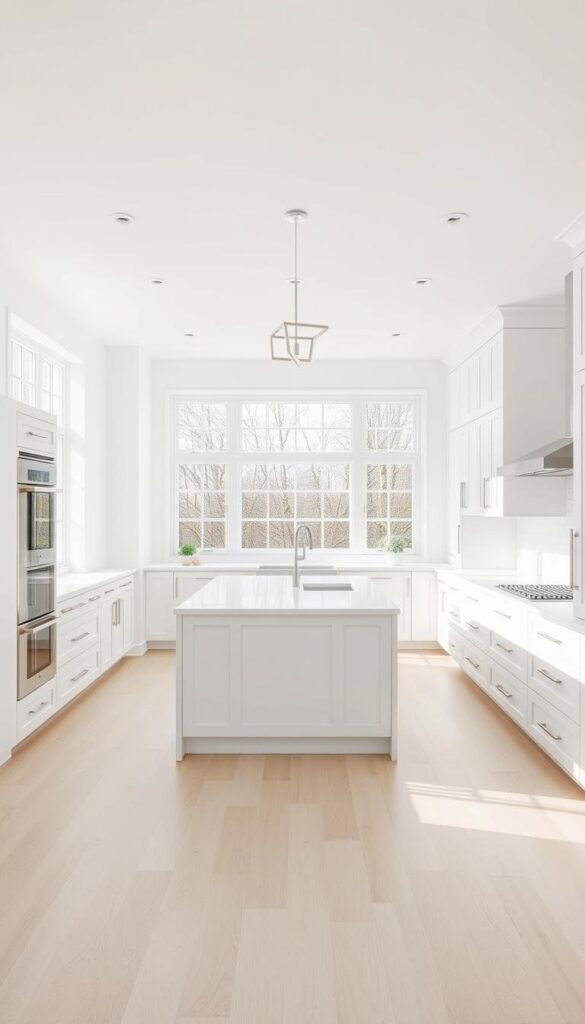
Cabinets: Choosing the Right Shade
White kitchen cabinets come in various shades. You can choose from crisp pure white to softer off-white tones. Matte finishes hide smudges, while glossy surfaces add shine.
Shaker-style cabinets offer timeless charm, and slab doors suit modern layouts. Materials like laminate resist scratches, while painted wood adds depth. Think about durability and cleaning ease when picking your shade.
Countertops: Material Options
Pairing white kitchen countertops with cabinets creates a seamless look. Choose materials that fit your lifestyle:
- Quartz: Durable and low-maintenance, perfect for busy areas.
- Marble: Adds elegance but needs sealing to prevent stains.
- Butcher block: Warm for modern spaces, easy to clean.
- Concrete: Sleek and industrial, with a matte finish.
Backsplashes: Adding Personality
A white kitchen backsplash can blend or stand out. Options include:
- Subway tiles in white for a classic touch.
- Bold patterns or colorful mosaics for visual interest.
- Ceramic or glass tiles add texture without overwhelming the space.
Each element, from white kitchen backsplash tiles to countertop material, shapes the room’s vibe. Mix and match to create a kitchen that feels stylish and livable.
Lighting Solutions for Bright White Spaces
Lighting is key to making a white kitchen design shine. The right lights and natural light can turn simple into stunning. Let’s look at how to mix brightness with style.
Natural Light: Maximizing Windows
White surfaces bounce light, making natural light vital. Big windows or skylights boost this effect. In sunny places like Arizona, UV-blocking films protect surfaces without blocking views.
In northern areas, double-paned windows keep warmth while letting light in. White kitchens do best with sheer curtains or blinds that spread sunlight evenly.
Fixtures: Statement Lighting Options
Light fixtures set a room’s mood. Here are some styles:
- Pendant lights: Schoolhouse Electric’s simple designs add a modern touch without overwhelming the space.
- Recessed lighting: Great for task areas like prep zones, Tech Lighting offers sleek options.
- Under-cabinet strips: LED strips from WAC Lighting highlight countertops subtly.
Match bold fixtures like a brass chandelier with white cabinets for contrast. Recessed or track lighting adds both functional and ambient light.
Incorporating Color Accents
A white kitchen is a blank canvas waiting for color. Adding color accents can turn a plain space into a lively, personal area. Here are some tips to mix bold colors with the kitchen’s bright base.

Choosing Hardware for Contrast
Metallic hardware can make small details stand out. Brass or copper can warm up a farmhouse or coastal kitchen. On the other hand, matte black handles create a sharp contrast with white cabinets. Chrome adds a sleek touch to modern kitchens.
It’s good to mix finishes carefully. For example, try combining brushed nickel with antique brass in a transitional style.
- Brass: Adds warmth to traditional or cottage white kitchens
- Matte black: Edgy contrast for industrial or minimalist spaces
- Chrome: Clean lines for contemporary white kitchen decor
Decorative Accessories and Textiles
Textiles like patterned dish towels or woven baskets add soft colors. Navy, terracotta, or blush hues complement white kitchens well. Coastal kitchens look great with blue-and-white striped fabrics, while midwestern designs might prefer earthy greens or burnt oranges.
Change your decor with the seasons. For example, use crimson textiles in winter and sunny yellows in spring.
Adding plants and art brings life to the space. Ceramic pots or abstract wall art in bold frames can anchor the room. Swap out accessories yearly to keep things fresh, like replacing a red vase with a geometric sculpture.
Layering textures, like linen napkins or a wool area rug, keeps the room bright while adding depth.
Functional Layouts That Work
Every kitchen needs a layout that balances style and function. The best white kitchen design starts with thoughtful spatial planning. Whether you prefer an open plan or a cozy enclosed space, smart zoning ensures your kitchen works as well as it looks.
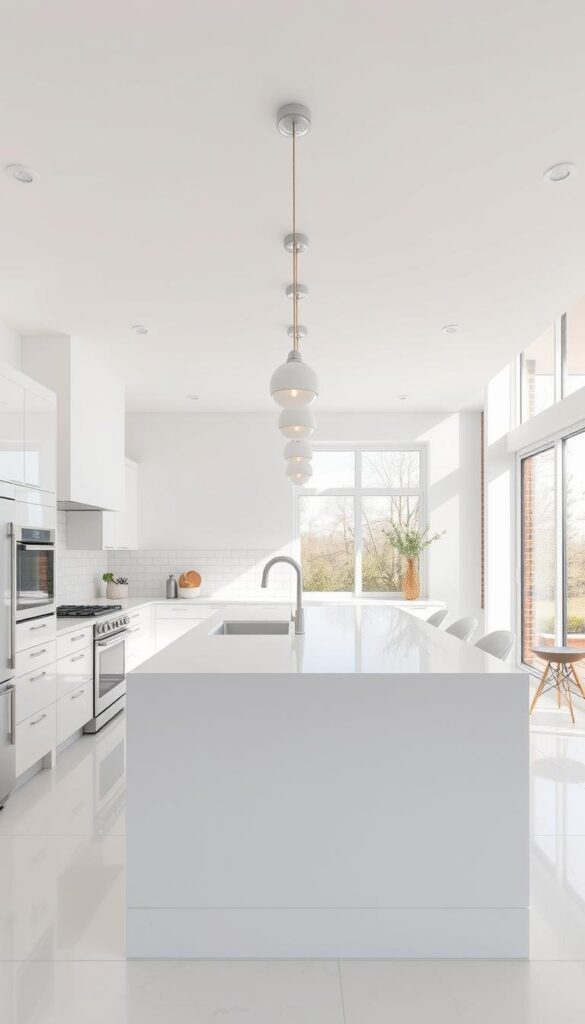
Open Concept vs. Closed Designs
“A well-designed open kitchen should feel like an extension of the living area, not a barrier.”
Open layouts pair perfectly withmodern white kitchenaesthetics. Light-colored cabinets from brands like IKEA or Shaker-style units from Crate & Barrel keep spaces airy. For traffic-heavy homes, use floating shelves or glass doors to maintain sightlines. Closed kitchens gain space-boosting effects from white subway tiles and matte finishes, as seen in Kohler’s small-space designs.
Work Zones for Efficiency
- Prep Zone: Place countertops near sinks and storage for groceries.
- Cook Zone: Cluster the stove, hood, and prep area for seamless cooking.
- Cleanup Zone: Position the dishwasher and recycling bins near the sink.
- Storage Zone: Use pull-out drawers from Blum or under-cabinet organizers to keep clutter hidden.
Modern white kitchens thrive when zones avoid visual clutter. A neutral backdrop like a white quartz countertop from Cambria lets functional elements take center stage. Prioritize walkways at least 36 inches wide to keep traffic flowing. Whether cooking for one or hosting, a well-planned layout ensures yourwhite kitchen designsupports your lifestyle.
Budgeting for Your Dream White Kitchen
Turning your kitchen into a crisp white space begins with smart budgeting. We’ll look at costs and strategies to get your dream kitchen without spending too much.
Costs to Consider
Renovating a white kitchen can cost a lot. Cabinets alone might be $1,500–$10,000, depending on the material. Countertops can be $1,000–$5,000, with quartz around $2,500–$4,000.
Backsplash prices start at $2–$5 per square foot. But, luxury stone can double that. Labor and appliances add another $5,000–$15,000, based on the brand.
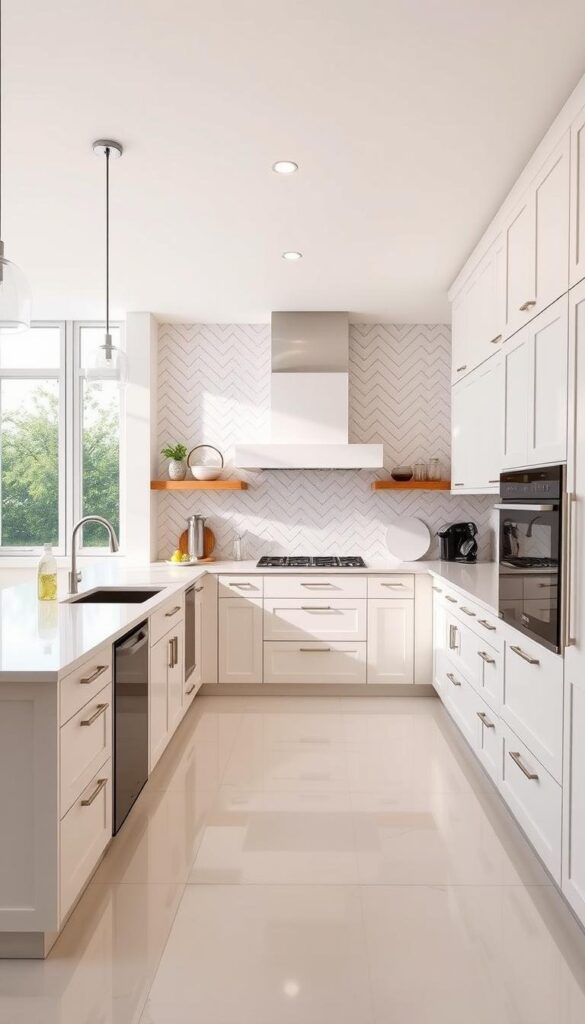
Tips for Staying on Budget
- Phase projects: Update cabinets first, then countertops later.
- Shop smart: Look for end-of-line discounts from brands like IKEA or Home Depot.
- Invest in longevity: Prioritize durable cabinetry but save on backsplash materials.
“A $15,000–$30,000 budget covers most mid-range white kitchen ideas,” says industry analyst Sarah Thompson. “Focus on value in core elements like cabinetry.”
Choosing wisely, like mixing affordable tiles with high-end cabinets, keeps your design looking good. Focus on quality in key areas like hardware or lighting. Small splurges here can make a big difference without breaking the bank.
Sustainability in White Kitchen Design

Today, white kitchen designs focus on being eco-friendly without losing beauty. Homeowners can make stylish kitchens that match their values. They do this by choosing materials and appliances that are good for the planet.
Eco-Friendly Materials
White kitchens can use materials like FSC-certified wood for cabinets or countertops from recycled glass. EcoTimber makes white cabinets from timber that’s been responsibly harvested. Appliances made from recycled stainless steel or quartz from post-consumer materials are both durable and stylish. Look for Cradle to Cradle or Greenguard certifications to know products are sustainable.
“A well-designed white kitchen can be both a hub of activity and a statement of environmental responsibility.” — National Kitchen + Bath Association
Energy-Efficient Appliances
- Opt for Energy Star-certified refrigerators, like KitchenAid’s French Door models, which use 15% less energy than standard models.
- Induction cooktops from brands such as Schultheiss cut energy use by up to 50% compared to gas ranges.
- Water-saving dishwashers from Samsung reduce consumption while maintaining performance.
White appliances fit well in any white kitchen and help save resources. Check EnergyStar.gov for rebates or local incentives to help with costs.
Maintenance Tips for a White Kitchen
Keeping a white kitchen looking great doesn’t mean endless cleaning. A few smart tips can help keep white kitchen cabinets and white kitchen countertops spotless all year. Start with simple daily habits to stop dirt from building up. Then, do deeper cleaning tasks at regular intervals.
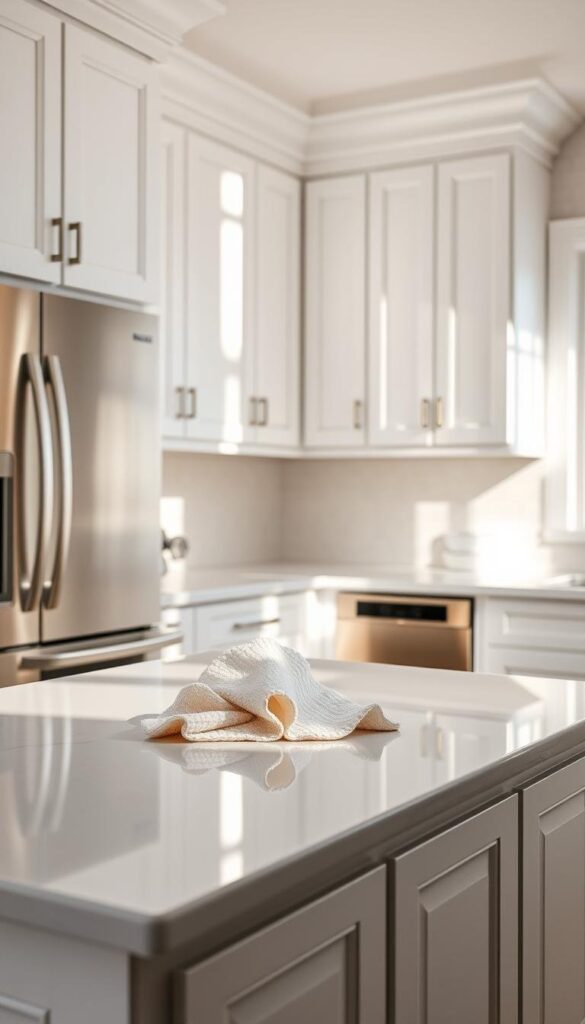
Keeping Surfaces Clean
- Wipe spills immediately: Use a microfiber cloth to avoid water marks on white kitchen countertops like quartz or marble.
- Weekly deep clean: Clean cabinet fronts with a solution of warm water and mild dish soap (try Dawn or Mrs. Meyer’s). Rinse with a damp cloth to prevent streaks.
- Seasonal touch-ups: Apply a wood polish like Minwax for painted cabinets every 6 months to restore shine.
Avoiding Stains and Discoloration
Protect surfaces with simple steps:
- Use coasters under glasses to prevent water rings on white kitchen countertops.
- Apply a stone sealer (e.g., Renaissance Wax) annually for porous surfaces like travertine.
- Opt for quartz or solid-surface countertops—they resist stains better than laminate.
Act fast when spills happen. Blot grease spills with a paper towel, then clean with a pH-neutral cleaner to avoid etching on stone surfaces. Regular care keeps white kitchens bright and inviting, without needing to be perfect.
Inspiring White Kitchen Examples
White kitchens fit any home, big or small. They show how design can make spaces work well. Use these ideas for your next kitchen update.
Clever Storage Solutions
In small kitchens, white cabinets make rooms feel bigger. Using slim appliances like Bosch refrigerators saves space. A subway tile white kitchen backsplash adds texture without taking up too much room.
This smart design turns small spaces into functional areas. It’s all about making the most of every inch in a modern white kitchen.
Luxury Meets Simplicity
High-end kitchens mix white with luxury materials. Floating oak shelves and glossy cabinets look great together. A marble white kitchen backsplash adds a touch of class.
Details like Dornbracht faucets and coffee systems add to the elegance. Even on a budget, you can find similar pieces that are more affordable.
Family-Friendly Functionality
Kitchens for families need to be both pretty and practical. Laminate countertops are durable and easy to clean. Open shelves display kids’ art without clutter.
Lower cabinets with soft-close drawers keep toys and snacks within reach. A chalkboard backsplash is both useful and fun. It’s a great white kitchen idea for kids to express themselves.
To bring you cozy inspiration more efficiently, we sometimes use AI to assist in content creation — but every word and idea is carefully shaped by our team. See our AI Disclosure for more info.







